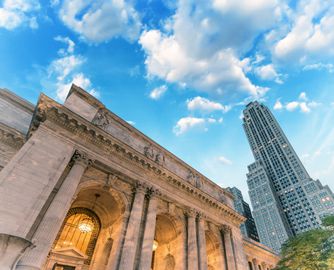

This particular branch of the city's public library system has almost as many names as it does books: sometimes it is called the Main Branch Library, the New York Public Library, the 42nd Street Library, the Library with the Lions and recently, among the financial elite, the Schwarzman Building, in honor of financier Stephen A. Schwarzman, who in 2008 donated $100 million for the buildings renovation and expansion.
The New York Public Library system was established in 1901. Steel magnate and America's second richest man at the time Andrew Carnegie donated $5.2 million, which would be roughly $150 million today, to build sixty-five branch libraries in the city. The Main Branch was built in marble in the Beaux-Arts style between 1897 and 1911 by the firm Carrere and Hastings. It was not the first branch to be erected, but it was definitely the biggest. It runs 290 feet north-south down Fifth Avenue and 270 feet east-west on 42nd Street, and has four floors, plus a cellar and a basement. The building was built over a reservoir and had a cost of $9 million. At the time it was the largest marble edifice in the US. The library's floor plan was designed on a postcard by its first director, John Shaw Billings. By the staircase leading to the main Fifth Avenue entrance lie two stone lions, sculpted by Edward Clark Potter. Originally they were called Leo Astor and Leo Lenox, in honor of the library's founders, John Jacob Astor and James Lenox. Then their names were changed in the 1930s by New York Mayor Fiorello La Guardia to Patience and Fortitude, in order to inspire New Yorkers to overcome with the Great Depression. There had been a third patron, Samuel Jones Tilden, whose collection, albeit much smaller, was also used for the library. However he was not honored with a lion. The six figures ensconced above the main entrance represent History, Drama, Poetry, Religion, Romance and Philosophy. The two ornate bronze flagpoles standing in front of the north and south wings were created by Italian sculptor Raffaele Menconi.
Upon its completion, the library was equipped with 75 miles of shelves and it took another year to transport all the collections from the separate Astor, Lenox and Tilden libraries. According to documents, the first book to be requested was Delia Bacon's Philosophy of the Plays of Shakespeare Unfolded. Yet, the first book to actually be lent out was Nikolai Grot's Moral Ideals of our Time, a study of Nietzsche and Tolstoy. The floors were considered so hard in the beginning that employees were given rubber-soled shoes. The Library's most famous reading chamber, the Rose Main Reading Room contains 25,000 reference books that can be consulted freely and is embellished by enormous windows, a carved and frescoed ceiling, mahogany tables, chandeliers and brass lamps illuminating seats for more than 700 potential readers.
In the 1980s the Main Building expanded east, acquiring 125,000 square feet of space. Today the New York Public Library system is the second largest public library in the US, after the Library of Congress, and third in the world - the first is the British Library. It has a total of 53.1 million different circulating and non-circulating item. The Library of Congress has 158 million and the British Library - 170 million.